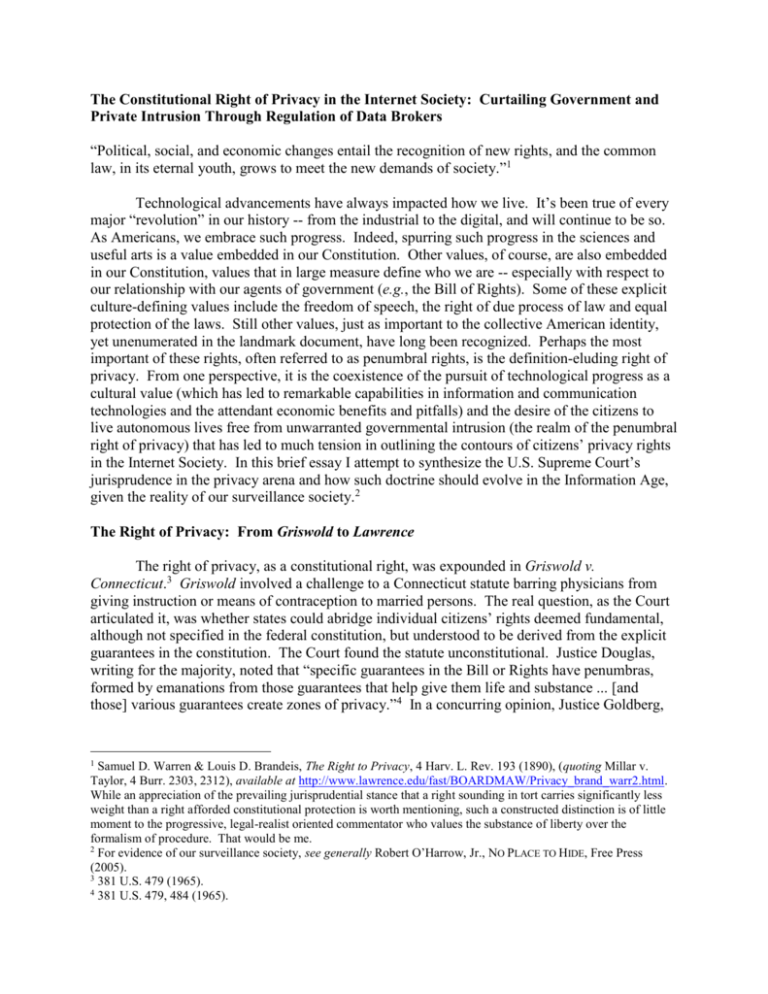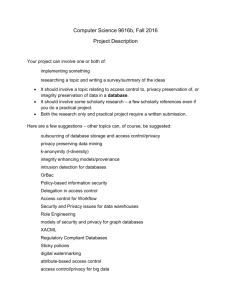The Constitutional Right of Privacy in the Internet Society: Curtailing
advertisement

The Constitutional Right of Privacy in the Internet Society: Curtailing Government and Private Intrusion Through Regulation of Data Brokers “Political, social, and economic changes entail the recognition of new rights, and the common law, in its eternal youth, grows to meet the new demands of society.”1 Technological advancements have always impacted how we live. It’s been true of every major “revolution” in our history -- from the industrial to the digital, and will continue to be so. As Americans, we embrace such progress. Indeed, spurring such progress in the sciences and useful arts is a value embedded in our Constitution. Other values, of course, are also embedded in our Constitution, values that in large measure define who we are -- especially with respect to our relationship with our agents of government (e.g., the Bill of Rights). Some of these explicit culture-defining values include the freedom of speech, the right of due process of law and equal protection of the laws. Still other values, just as important to the collective American identity, yet unenumerated in the landmark document, have long been recognized. Perhaps the most important of these rights, often referred to as penumbral rights, is the definition-eluding right of privacy. From one perspective, it is the coexistence of the pursuit of technological progress as a cultural value (which has led to remarkable capabilities in information and communication technologies and the attendant economic benefits and pitfalls) and the desire of the citizens to live autonomous lives free from unwarranted governmental intrusion (the realm of the penumbral right of privacy) that has led to much tension in outlining the contours of citizens’ privacy rights in the Internet Society. In this brief essay I attempt to synthesize the U.S. Supreme Court’s jurisprudence in the privacy arena and how such doctrine should evolve in the Information Age, given the reality of our surveillance society.2 The Right of Privacy: From Griswold to Lawrence The right of privacy, as a constitutional right, was expounded in Griswold v. Connecticut.3 Griswold involved a challenge to a Connecticut statute barring physicians from giving instruction or means of contraception to married persons. The real question, as the Court articulated it, was whether states could abridge individual citizens’ rights deemed fundamental, although not specified in the federal constitution, but understood to be derived from the explicit guarantees in the constitution. The Court found the statute unconstitutional. Justice Douglas, writing for the majority, noted that “specific guarantees in the Bill or Rights have penumbras, formed by emanations from those guarantees that help give them life and substance ... [and those] various guarantees create zones of privacy.”4 In a concurring opinion, Justice Goldberg, 1 Samuel D. Warren & Louis D. Brandeis, The Right to Privacy, 4 Harv. L. Rev. 193 (1890), (quoting Millar v. Taylor, 4 Burr. 2303, 2312), available at http://www.lawrence.edu/fast/BOARDMAW/Privacy_brand_warr2.html. While an appreciation of the prevailing jurisprudential stance that a right sounding in tort carries significantly less weight than a right afforded constitutional protection is worth mentioning, such a constructed distinction is of little moment to the progressive, legal-realist oriented commentator who values the substance of liberty over the formalism of procedure. That would be me. 2 For evidence of our surveillance society, see generally Robert O’Harrow, Jr., NO PLACE TO HIDE, Free Press (2005). 3 381 U.S. 479 (1965). 4 381 U.S. 479, 484 (1965). quoting from Powell v. Alabama5, reiterated that “[t]he inquiry is whether a right involved is of such a character that it cannot be denied without violating those fundamental principles of liberty and justice which lie at the base of all our civil and political institutions ...” (internal quotations omitted).6 Since Griswold the Court has continued to recognize the right of privacy in what might be deemed “decisional” or “physical space-specific” contexts (e.g., Roe v. Wade7, Whalen v. Roe8, Planned Parenthood v. Casey9, Chandler v. Miller10, and Lawrence v. Texas11, which overruled the only case in the Griswold progeny to significantly deviate from the “right of privacy doctrine,” Bowers v. Hardwick12). What it has not done, however, is provide a workable framework for protecting citizens from what has been referred to as “intangible invasions” in the Internet Society – that is, freedom extending beyond spatial bounds.13 So, Does Freedom Extend Beyond Spatial Bounds: What to Make of Intangible Invasions Where Private Affairs Are Exploited by Others? It is worth noting, as Justice Black did in his dissent in Griswold, that the notion of a “right to privacy” was first developed in a law review article co-authored by Louis D. Brandeis as a means of providing a basis of “tort relief to persons whose private affairs were exploited by others.”14 The powerful idea expressed in this inconspicuous footnote embodies the progressive value that must be embraced if we are to curtail the intrusions made possible by the merger of data aggregators, analysts and government.15 Recall Justice Stewart’s memorable assertion in Katz v. United States, “For the Fourth Amendment protects people, not places. What a person knowingly exposes to the public, even in his own home or office, is not a subject of Fourth Amendment protection ... But what he seeks to preserve as private, even in an area accessible to the public, may be constitutionally protected” (emphasis added).16 In Katz, federal agents attached an eavesdropping device to the outside of a public phone booth used by Katz. Based on recordings of his end of the conversations, Katz was 5 287 U.S. 45, 67 (1932). 381 U.S. 479, 493 (1965). 7 410 U.S. 113 (1973) (protecting woman’s right to terminate pregnancy). 8 429 U.S. 589 (1977) (upholding statute requiring identification of persons obtaining certain drugs by prescription, where “public disclosure of the identity of patients is expressly prohibited ...”) (emphasis added). 9 505 U.S. 833 (1992) (reaffirmed Roe, but it imposed a new standard to determine the validity of laws restricting abortions: whether a state abortion regulation has the purpose or effect of imposing an “undue burden,” which is defined as a “substantial obstacle in the path of a woman seeking an abortion before the fetus attains viability.”) 10 520 U.S. 305 (1997) (holding unconstitutional a Georgia statute requiring candidates for certain public offices to take drug test). 11 539 U.S. 558 (2003) (overruled Bowers v. Hardwick, holding that right to liberty gives homosexuals the full right to engage in their conduct without intervention from the government.) 12 478 U.S. 186 (holding Constitution provided no fundamental right to engage in homosexual sodomy). 13 Laurence H. Tribe, The Constitution in Cyberspace: Law and Liberty Beyond the Electronic Frontier, available at http://www.epic.org/free_speech/tribe.html. 14 381 U.S. 479, 510 (1965); Warren & Brandeis, supra note 1. 15 While the Privacy Act of 1974 precludes the government from maintaining data on citizens not targeted for investigations, there are no comparable restrictions prohibiting government from contracting with private sector entities not subject to the restriction. 16 389 U.S. 347, 351 (1967). 6 convicted under an eight-count indictment for the illegal transmission of wagering information from Los Angeles to Boston and Miami. The Court ruled that Katz was entitled to Fourth Amendment protection for his conversations and that a physical intrusion into the area he occupied was unnecessary to bring the Amendment into play. A thorough reading of the Griswold line of cases, and Katz, reveals that it is the intent of the person subject to a privacy intrusion that matters most – not the interests of the government or private data brokers. The question then becomes whether Americans are “knowingly” exposing profiling data to the public (including government) when engaging in arms length transactions with private sector entities, or “seeking to preserve” such information as private and only disclosed to the party in privity. When viewed through the lens of privacy, “knowingly” has to be construed to mean actual, not merely constructive, notice. And in the Internet society, actual notice must go beyond inconspicuous and largely unread privacy policies written in legal jargon. Moreover, “seeking to preserve” should be the rebuttable presumption afforded citizens, undermined only by acquiescence to a clear and conspicuous policy to the contrary. In the words of Professor Tribe, “[s]cience and technology open options ... [t]hey do not alter what is right or what is wrong ... The Constitution’s norms, at their deepest level, must be invariant under merely technological transformations.”17 [In a follow up to this essay I propose statutory language, with interpretational guidance, designed to effect the changes deemed necessary to restore privacy and slow down Big Brother and his private sector accomplices.] 17 Tribe, supra note 8.






